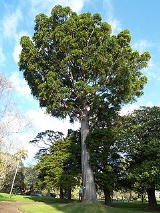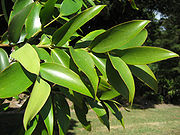
Agathis robusta
Encyclopedia
Agathis robusta is a coniferous
tree
in the family Araucariaceae
, native to eastern Queensland
, Australia
. It occurs in two localities, a southern population on Fraser Island and around Maryborough
, and a northern population on the Atherton Tableland
west of Cairns
; the northern population was formerly distinguished as Agathis palmerstonii, but does not differ from the southern population and is no longer considered distinct (Whitmore 1980). Trees in Papua New Guinea
previously referred to Agathis robusta are now treated as a distinct species Agathis spathulata
(de Laubenfels 1988).

 It is a large evergreen
It is a large evergreen
tree growing straight and tall to a height of 30-50 m, with smooth, scaly bark
. The leaves
are 5-12 cm long and 2-5 cm broad, tough and leathery in texture, with no midrib; they are arranged in opposite pairs (rarely whorls of three) on the stem. The seed cones
are globose, 8-13 cm diameter, and mature in 18-20 months after pollination; they disintegrate at maturity to release the seed
s. The male (pollen
) cones are cylindrical, 5-10 cm long and 1-1.5 cm thick.
The Queensland Kauri was heavily logged in the past, and spectacular trees of prodigious size are much rarer than in pre-European times; despite this, the species as a whole is not endangered.
Pinophyta
The conifers, division Pinophyta, also known as division Coniferophyta or Coniferae, are one of 13 or 14 division level taxa within the Kingdom Plantae. Pinophytes are gymnosperms. They are cone-bearing seed plants with vascular tissue; all extant conifers are woody plants, the great majority being...
tree
Tree
A tree is a perennial woody plant. It is most often defined as a woody plant that has many secondary branches supported clear of the ground on a single main stem or trunk with clear apical dominance. A minimum height specification at maturity is cited by some authors, varying from 3 m to...
in the family Araucariaceae
Araucariaceae
Araucariaceae, commonly referred to as araucarians, is a very ancient family of coniferous trees. It achieved its maximum diversity in the Jurassic and Cretaceous periods, when it was distributed almost worldwide...
, native to eastern Queensland
Queensland
Queensland is a state of Australia, occupying the north-eastern section of the mainland continent. It is bordered by the Northern Territory, South Australia and New South Wales to the west, south-west and south respectively. To the east, Queensland is bordered by the Coral Sea and Pacific Ocean...
, Australia
Australia
Australia , officially the Commonwealth of Australia, is a country in the Southern Hemisphere comprising the mainland of the Australian continent, the island of Tasmania, and numerous smaller islands in the Indian and Pacific Oceans. It is the world's sixth-largest country by total area...
. It occurs in two localities, a southern population on Fraser Island and around Maryborough
Maryborough, Queensland
Maryborough is a city located on the Mary River in South East Queensland, Australia, approximately north of the state capital, Brisbane. The city is serviced by the Bruce Highway, and has a population of approximately 22,000 . It is closely tied to its neighbour city Hervey Bay which is...
, and a northern population on the Atherton Tableland
Atherton Tableland
The Atherton Tableland is a fertile plateau which is part of the Great Dividing Range in Queensland, Australia. It is located west to south-south-west inland from Cairns, well into the tropics, but its elevated position provides a climate suitable for dairy farming. It has an area of around...
west of Cairns
Cairns, Queensland
Cairns is a regional city in Far North Queensland, Australia, founded 1876. The city was named after William Wellington Cairns, then-current Governor of Queensland. It was formed to serve miners heading for the Hodgkinson River goldfield, but experienced a decline when an easier route was...
; the northern population was formerly distinguished as Agathis palmerstonii, but does not differ from the southern population and is no longer considered distinct (Whitmore 1980). Trees in Papua New Guinea
Papua New Guinea
Papua New Guinea , officially the Independent State of Papua New Guinea, is a country in Oceania, occupying the eastern half of the island of New Guinea and numerous offshore islands...
previously referred to Agathis robusta are now treated as a distinct species Agathis spathulata
Agathis spathulata
Agathis spathulata is a species of Agathis native to the highlands of eastern Papua New Guinea, occurring at altitudes of 900-1980 m. Although long known, it has only relatively recently been distinguished from Agathis robusta, being described first as a subspecies of it, Agathis robusta subsp...
(de Laubenfels 1988).


Evergreen
In botany, an evergreen plant is a plant that has leaves in all seasons. This contrasts with deciduous plants, which completely lose their foliage during the winter or dry season.There are many different kinds of evergreen plants, both trees and shrubs...
tree growing straight and tall to a height of 30-50 m, with smooth, scaly bark
Bark
Bark is the outermost layers of stems and roots of woody plants. Plants with bark include trees, woody vines and shrubs. Bark refers to all the tissues outside of the vascular cambium and is a nontechnical term. It overlays the wood and consists of the inner bark and the outer bark. The inner...
. The leaves
Leaf
A leaf is an organ of a vascular plant, as defined in botanical terms, and in particular in plant morphology. Foliage is a mass noun that refers to leaves as a feature of plants....
are 5-12 cm long and 2-5 cm broad, tough and leathery in texture, with no midrib; they are arranged in opposite pairs (rarely whorls of three) on the stem. The seed cones
Conifer cone
A cone is an organ on plants in the division Pinophyta that contains the reproductive structures. The familiar woody cone is the female cone, which produces seeds. The male cones, which produce pollen, are usually herbaceous and much less conspicuous even at full maturity...
are globose, 8-13 cm diameter, and mature in 18-20 months after pollination; they disintegrate at maturity to release the seed
Seed
A seed is a small embryonic plant enclosed in a covering called the seed coat, usually with some stored food. It is the product of the ripened ovule of gymnosperm and angiosperm plants which occurs after fertilization and some growth within the mother plant...
s. The male (pollen
Pollen
Pollen is a fine to coarse powder containing the microgametophytes of seed plants, which produce the male gametes . Pollen grains have a hard coat that protects the sperm cells during the process of their movement from the stamens to the pistil of flowering plants or from the male cone to the...
) cones are cylindrical, 5-10 cm long and 1-1.5 cm thick.
The Queensland Kauri was heavily logged in the past, and spectacular trees of prodigious size are much rarer than in pre-European times; despite this, the species as a whole is not endangered.

